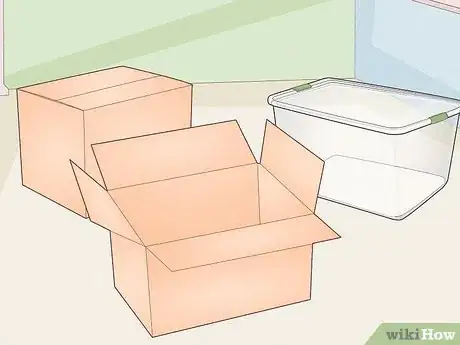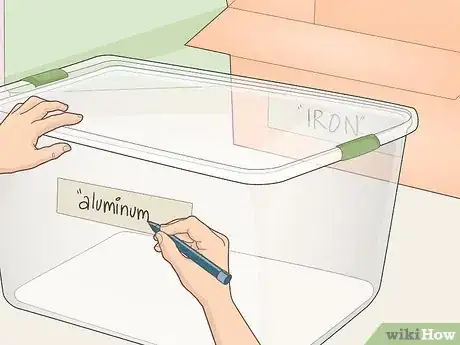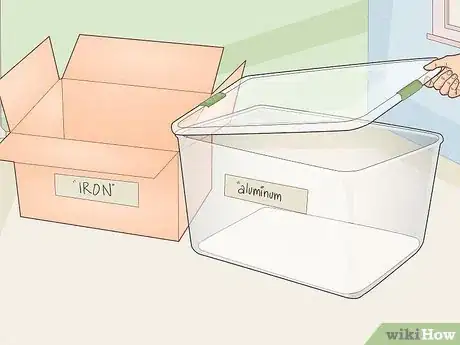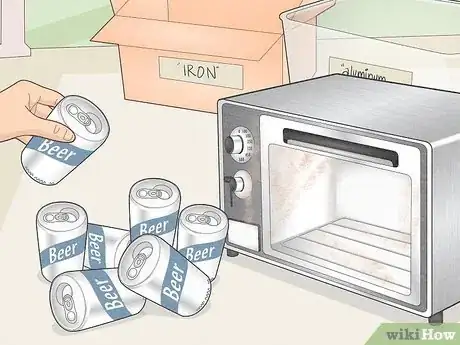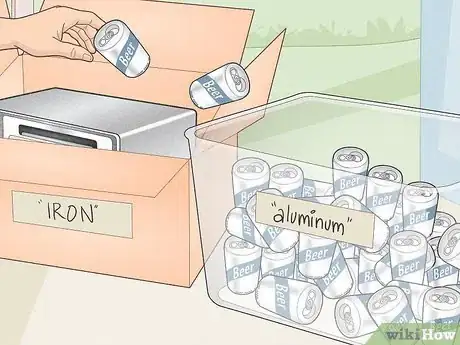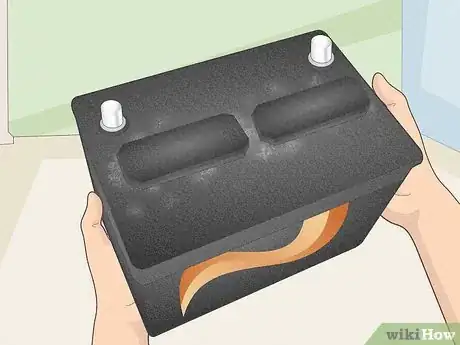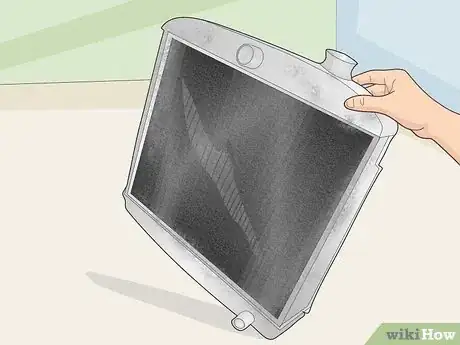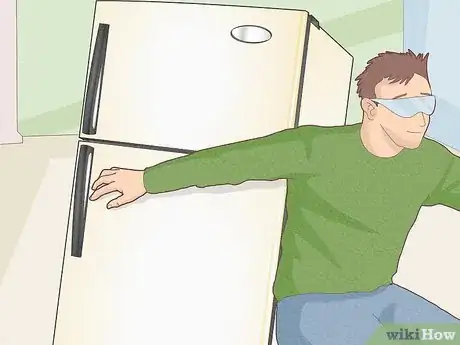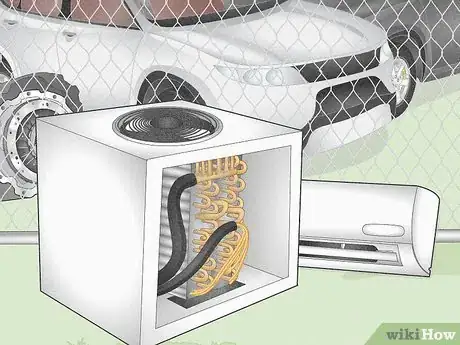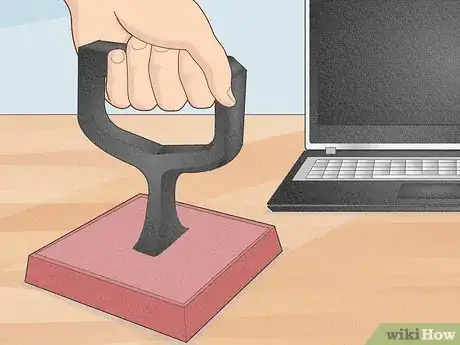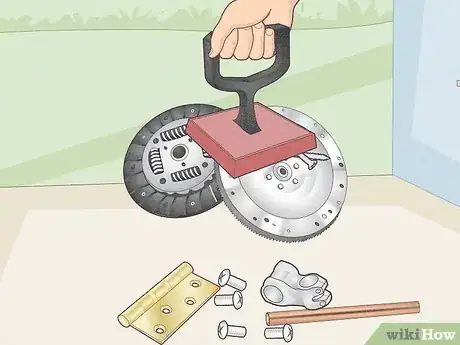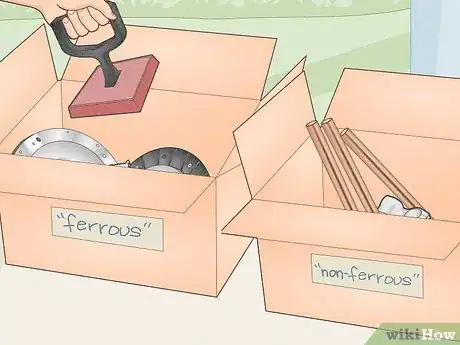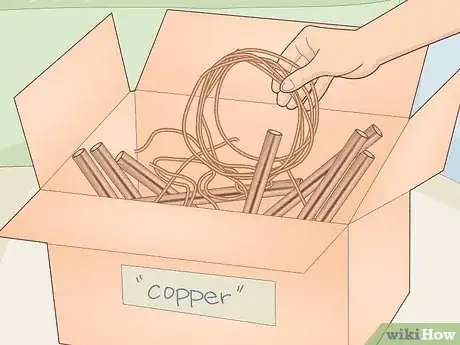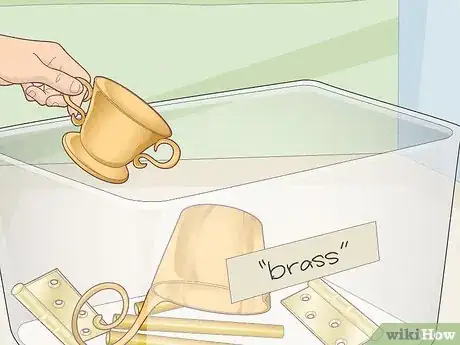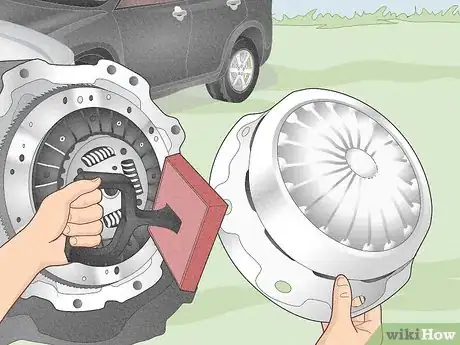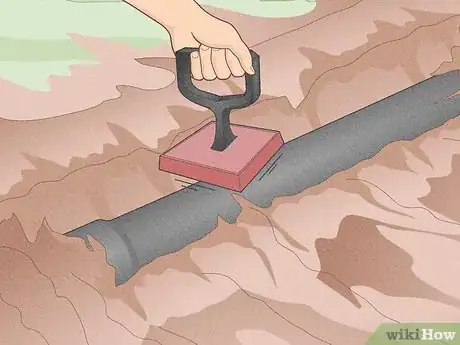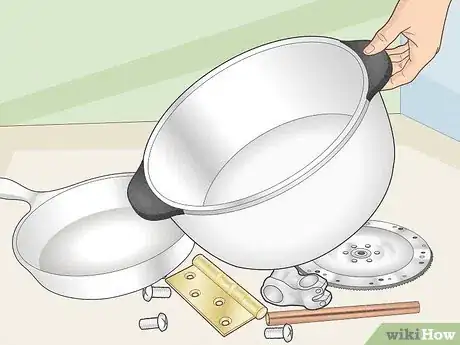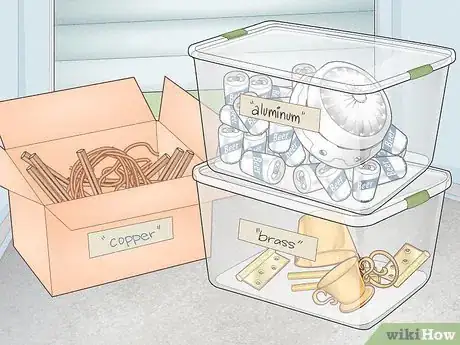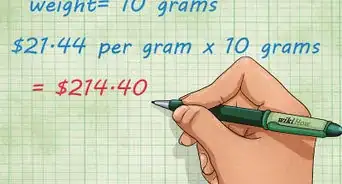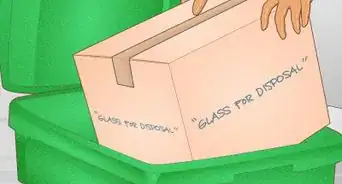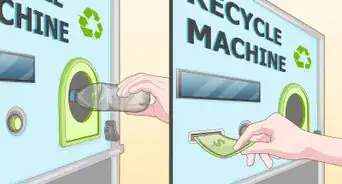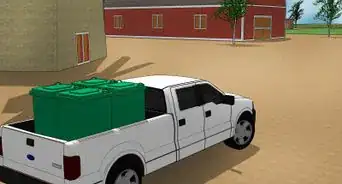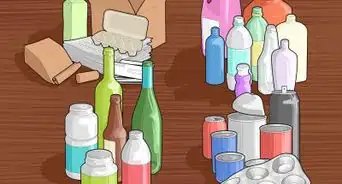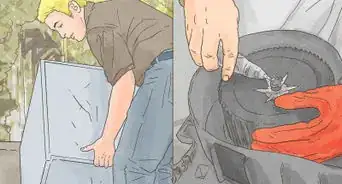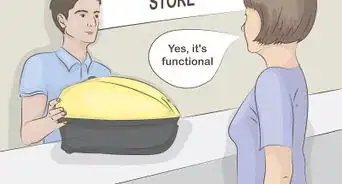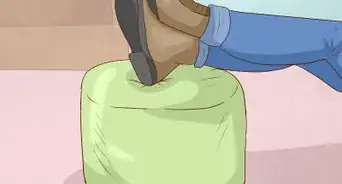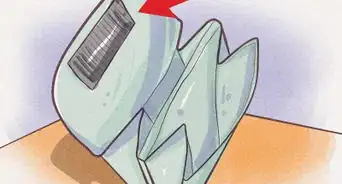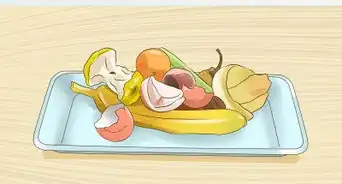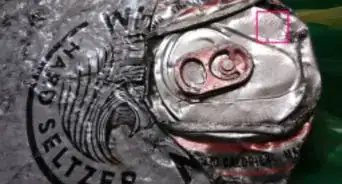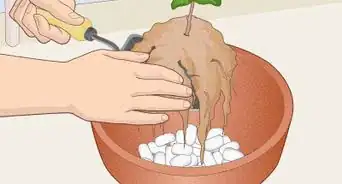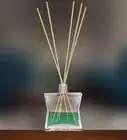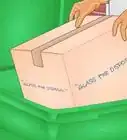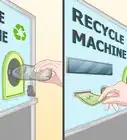This article was co-authored by Kathryn Kellogg and by wikiHow staff writer, Kyle Hall. Kathryn Kellogg is the founder of goingzerowaste.com, a lifestyle website dedicated to breaking eco-friendly living down into a simple step-by-step process with lots of positivity and love. She's the author of 101 Ways to Go Zero Waste and spokesperson for plastic-free living for National Geographic.
There are 8 references cited in this article, which can be found at the bottom of the page.
This article has been viewed 157,071 times.
Selling scrap metal can be a great way to supplement your income, or you can do it full time. Before you can sell your scrap metal to a scrap yard, you need to separate the different metals in your scrap. A scrap magnet will help you locate the iron in your scrap. From there you can observe the color and weight of the remaining metals to see what kind they are. Once your scrap metal is sorted into bins, you can take it to the nearest scrap yard and collect your payment.
Steps
Setting Up a Work Area
-
1Get containers to separate your metals in. Use large plastic bins, cardboard boxes, or any other large containers you can find. Make sure you’re getting containers large enough to hold the amount of metal you plan on scrapping.
-
2Label the different containers. Write on them with a permanent marker or stick pieces of masking tape on them and write the label on the tape. Assign each container to a different kind of metal.
- For example, one container would be labeled “aluminum,” and another container would be labeled “iron.”
- Ideally you should have at least one container for each kind of metal you’ll encounter while scrapping, including copper, brass, stainless steel, aluminum, and iron.
Advertisement -
3Set up the containers in your work area. Organize them so they’re easy to reach and access. Position the containers so the labels are facing where you’ll be sorting through the scrap metal. That way you can easily find the bin you need when you’re sorting.
-
4Accumulate scrap metal. Get scrap metal from old junk cars you have. Save old appliances like refrigerators and ovens. Look for old electronics around your home or on the side of the street and collect them. Save aluminum cans. Old laptops, computer towers, and cell phones can also have scrap metal inside them.[1]
-
5Start sorting your scrap when you have enough to fill your bins. Save yourself time by waiting until you have a lot of scrap to sell instead of making several trips to the scrap yard with smaller loads. You can also sort your scrap into bins as you collect it and then take it to the scrap yard once your bins are full.
Sorting Whole Items
-
1Hold onto any car batteries you find. Car batteries contain lead, so scrap yards will buy them. If you're scrapping an old junk car, set the battery aside in its own pile. Take it with you to the scrap yard when you bring your other metals.[2]
-
2Save car radiators. Car radiators can contain aluminum and brass. Separate radiators with brass from radiators with aluminum before you take them into the scrap yard.[3]
-
3Store whole appliances to bring to the scrap yard. Many scrap yards will buy appliances, like refrigerators, from you and take them apart for the scrap inside. Don't worry about extracting the scrap metal from appliances yourself.[4]
-
4Bring whole air conditioning units to the scrap yard. Don't worry about taking the units apart yourself. Stockpile any AC units you find and bring them to the scrap yard along with all your sorted metals.[5]
-
5Collect whole computer towers. Taking apart computer towers for the scrap metal inside is time consuming, and it won't get you more money than selling the tower as a whole unit. Set aside any computer towers you find and bring the whole units with you to the scrap yard.[6]
Testing Metals with a Magnet
-
1Get a scrap magnet online. A scrap magnet is a powerful magnet you can use to sort ferrous and non-ferrous metals. A regular household magnet won’t work. You’ll need to get a scrap magnet to properly sort your metals.[7]
-
2Test each piece of scrap metal with the magnet. Place the magnet against the surface of the scrap metal. Pull the magnet away. If the scrap metal sticks to the magnet, it’s a ferrous metal. If it doesn’t stick, it’s non-ferrous.[8]
-
3Separate ferrous and non-ferrous metals into two piles. This will make it easier to sort through the metals later. Ferrous metals always contain iron. You’ll know that your pile of ferrous metal is mostly all iron. Then you’ll just need to sort through the non-ferrous pile of metals.[9]
- The metals in the non-ferrous pile will likely be more valuable. They could include metals like aluminum, lead, copper, and brass.
Sorting Non-Ferrous Metals
-
1Check pipes and wires for copper. Copper has a reddish brown color. If you come across any copper, place it in the container labeled “copper.”[10]
-
2Sort yellow metals into the “brass” bin. Most of the yellow metals you encounter are likely brass. Don’t confuse brass with gold. Gold has more of a brown color to it than brass, and it's rarer to come by.
- Brass is commonly found in pipe fittings, valves, bullet casings, faucets, and doorknobs.[11]
-
3Look for aluminum in cars, boats, and building materials. Aluminum is a lightweight and silver metal. Check over aluminum with your scrap magnet to make sure there’s no iron attached. If there is, remove it before you take it to the scrap yard or you won’t get full price for your aluminum.[12]
- Other places you might find aluminum are window frames, airplanes, bikes, and wheelchairs.
-
4Check heavy items for dark gray lead. Piping is commonly made out of lead. You can also find lead in the wheel weights on cars, in wiring, and in lead batteries.[13]
-
5Look for stainless steel in your scrap. Stainless steel is silver and usually very reflective. Check for stainless steel in household appliances and cooking supplies like pots and pans.[14]
-
6Store the containers of metal in a safe place until you sell them. Don't leave the containers outdoors where someone could steal them. Keep them locked in your home or garage. You can also keep your scrap metal in a storage container until you're ready to visit the scrap yard.
Expert Q&A
-
QuestionWhat will scrap yards not take?
 Kathryn KelloggKathryn Kellogg is the founder of goingzerowaste.com, a lifestyle website dedicated to breaking eco-friendly living down into a simple step-by-step process with lots of positivity and love. She's the author of 101 Ways to Go Zero Waste and spokesperson for plastic-free living for National Geographic.
Kathryn KelloggKathryn Kellogg is the founder of goingzerowaste.com, a lifestyle website dedicated to breaking eco-friendly living down into a simple step-by-step process with lots of positivity and love. She's the author of 101 Ways to Go Zero Waste and spokesperson for plastic-free living for National Geographic.
Recycling Educator Make sure to recycle electronics with an appropriate facility. There are a lot of precious metals in our phones, so your old electronics can be very valuable. However, they also contain hazardous wastes, so it's important to make sure you're selling them to someone who's certified to deal with those wastes.
Make sure to recycle electronics with an appropriate facility. There are a lot of precious metals in our phones, so your old electronics can be very valuable. However, they also contain hazardous wastes, so it's important to make sure you're selling them to someone who's certified to deal with those wastes. -
QuestionHow do I separate metals that have melted together?
 Community AnswerIt depends on the metals. For some, it isn't (realistically) possible. However, if it is possible, it will likely fall into one of a few categories. If your metals are of different densities, then you can melt them and siv the lighter metal off the top. Chemically, if one of the metal is reactive with a certain substance and the other is not, then exposing it to that substance will pull out one of the metals. In some cases, hydrolysis will be able to separate alloys that have been melted down.
Community AnswerIt depends on the metals. For some, it isn't (realistically) possible. However, if it is possible, it will likely fall into one of a few categories. If your metals are of different densities, then you can melt them and siv the lighter metal off the top. Chemically, if one of the metal is reactive with a certain substance and the other is not, then exposing it to that substance will pull out one of the metals. In some cases, hydrolysis will be able to separate alloys that have been melted down. -
QuestionCan I scrap cast-iron frying pans?
 Community AnswerYes. Remove rubber, any bright trim etc. Identify bright silvery trim and sell that separately. Scrapyards will take washed cast-iron pans once anything non-iron has been removed.
Community AnswerYes. Remove rubber, any bright trim etc. Identify bright silvery trim and sell that separately. Scrapyards will take washed cast-iron pans once anything non-iron has been removed.
Things You’ll Need
- Scrap metal
- Large containers
- Permanent marker
- Masking tape
- Scrap magnet
References
- ↑ https://iscrapapp.com/blog/where-can-i-find-scrap-metal/
- ↑ https://wellkeptwallet.com/sell-car-batteries-for-cash/
- ↑ https://iscrapapp.com/blog/how-to-scrap-dirty-copper-radiators/
- ↑ https://wellkeptwallet.com/how-to-get-cash-for-your-old-refrigerator/
- ↑ https://iscrapapp.com/blog/beginners-guide-scrapping-101/
- ↑ https://iscrapapp.com/blog/beginners-guide-scrapping-101/
- ↑ http://www.scrapmetaljunkie.com/230/the-magnet-test-2
- ↑ http://www.scrapmetaljunkie.com/230/the-magnet-test-2
- ↑ http://www.scrapmetaljunkie.com/230/the-magnet-test-2
- ↑ http://www.scrapmetaljunkie.com/236/how-to-sell-scrap-copper-2
- ↑ http://www.artofmanliness.com/2014/11/13/turning-junk-into-gold-how-to-make-money-scrapping-metal/
- ↑ http://www.artofmanliness.com/2014/11/13/turning-junk-into-gold-how-to-make-money-scrapping-metal/
- ↑ http://www.artofmanliness.com/2014/11/13/turning-junk-into-gold-how-to-make-money-scrapping-metal/
- ↑ http://www.artofmanliness.com/2014/11/13/turning-junk-into-gold-how-to-make-money-scrapping-metal/
